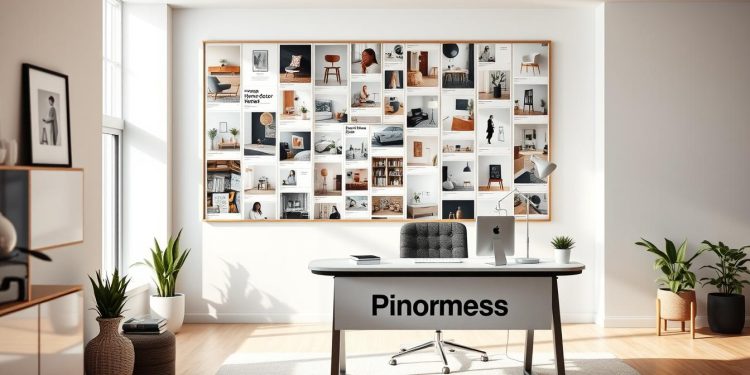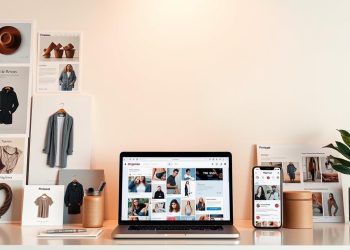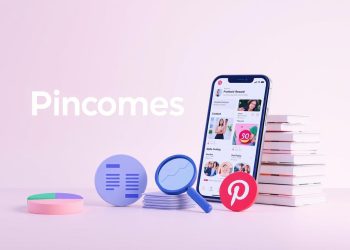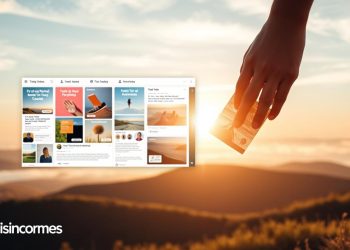Imagine a platform where users actively search for inspiration to spend money. That’s Pinterest – where over 23 billion pins in the lifestyle category prove its unmatched power for creative businesses. For designers and bloggers, this isn’t just social media. It’s a goldmine waiting to be tapped.
Visual platforms now drive 85% more engagement than text-based content. But most creators miss the mark by treating Pinterest like other networks. The secret? Treat pins as conversion tools, not just pretty pictures. When optimized correctly, each image becomes a direct path to your services or products.
This guide reveals how to transform scrollers into buyers. You’ll learn to craft pins that showcase expertise while subtly guiding viewers toward your offerings. From color psychology in thumbnails to strategic keyword placement, we break down what makes top-performing content click.
Key Takeaways
- Pinterest users spend 30% more on home-related purchases than other social media audiences
- Optimized pins generate website traffic for up to 18 months after posting
- Top performers use seasonal trends to boost visibility by 200%
- Strategic keyword placement doubles pin discoverability
- Video pins receive 3x more saves than static images
Set Up and Optimize Your Pinterest Business Profile
Ready to turn your passion into profit? Start by switching to a Pinterest business account. Unlike personal profiles, this free upgrade unlocks tools like pinterest analytics and rich pins that track engagement. Business accounts also rank higher in searches – crucial for standing out in competitive niches.
Enhance Your Profile Picture and Brand Identity
Your profile picture acts as a visual handshake. Use a high-resolution logo or professional headshot that matches your website branding. Pro tip: Test visibility by shrinking the image to 165×165 pixels – it should remain crisp on all devices.
Create a Keyword-Rich Bio and Detailed Links
Transform your bio into a search magnet. Blend services with strategic phrases like “luxury space design” or “renovation expert”. For example: “Award-winning designer | Transforming urban apartments | Download our free color palette guide”.
Link strategically: Drive traffic through your website URL while connecting Instagram or YouTube for cross-platform growth. Update these quarterly to promote new offers or seasonal content.
Remember: Every element works together. Use pinterest analytics later to measure what resonates. Track profile visits and outbound clicks to refine your approach. Your optimized presence becomes a 24/7 lead generator – make it count.
Design Cohesive Boards and High-Quality Content for Home Decor
Visual harmony drives decisions faster than scattered ideas. Your boards act as curated galleries – each pin a chapter in your brand’s story. Start by grouping concepts like “Modern Kitchen Upgrades” or “Small Space Solutions” to align with what designers actually search.

Master Visual Storytelling Through Themed Boards
Names matter. Blend top keywords like “biophilic design ideas” or “budget-friendly makeovers” into board titles. This isn’t just labeling – it’s SEO magic that pushes your content into discovery feeds. Analyze trending searches monthly to stay relevant.
Elevate Content Quality With Smart Repurposing
Transform Instagram reels into step-by-step pin tutorials. Use Canva’s brand kit to maintain color consistency across images. Pro tip: Vertical pins (2:3 ratio) dominate feeds – optimize every graphic for mobile-first viewing.
Tools like Tailwind let you schedule pins during peak engagement hours (8-11 PM EST works best). Consistency builds trust. Mix fresh creations with evergreen posts to keep boards lively while driving traffic website visits year-round.
Remember: Every pin should answer a question or solve a problem. Balance aspirational mood boards with actionable checklists. When viewers find both inspiration and practical value, they’ll bookmark your content – and eventually, your services.
Implement Home Decor Pinterest Marketing Strategy
72% of Pinners actively plan purchases while browsing. This platform thrives on intent-driven users seeking solutions. To convert scrollers into buyers, you need razor-sharp audience insights. Start by analyzing platform demographics – 40% are women aged 25-40 planning home upgrades.
Map User Journeys to Fuel Conversions
Successful campaigns begin with behavioral data. Track what your ideal clients search for – “apartment-friendly layouts” or “renovation checklists” reveal pain points. Tools like Pinterest Trends show rising queries like “modular furniture ideas”, up 140% this year.
Set goals that align with business needs:
| Audience Segment | Content Type | Objective |
|---|---|---|
| Millennial Renters | Space-saving tutorials | Email sign-ups |
| DIY Enthusiasts | Budget makeover guides | E-book sales |
| Luxury Buyers | Custom design showcases | Consultation bookings |
One interior designer boosted client inquiries by 300% using targeted pins. “We created ‘Before/After’ carousels for specific neighborhoods – it made our work relatable,” she explains. Add clear CTAs like “Download our flooring comparison chart” to bridge inspiration and action.
Review analytics monthly. If “outdoor patio ideas” pins drive traffic but no conversions, tweak landing pages or offer free consultations. Platforms evolve – so should your strategy.
Schedule Pins and Maintain Consistent Posting
What separates fleeting trends from lasting results? Consistent visibility. Regular pinning keeps your boards fresh and your profile prioritized in search algorithms. Tools like Tailwind transform chaotic posting into strategic momentum – think of it as autopilot for your best content.

Smart Scheduling = Steady Growth
Manual pinning burns time. Automated systems let you batch-create content while targeting peak engagement windows. One designer reported 47% more saves after switching to scheduled posts. Here’s how to make it work:
| Feature | Manual Pinning | Scheduled Pinning |
|---|---|---|
| Posting Frequency | Inconsistent | 3-5x daily |
| Peak Time Targeting | Missed opportunities | Auto-optimized |
| Brand Consistency | Variable | Style templates applied |
Start by auditing top-performing pins. Use Tailwind’s SmartSchedule to reshare them with updated keywords. Sync your calendar with seasonal trends – post patio ideas in spring, cozy interiors by fall.
Repurpose evergreen content quarterly. Swap backgrounds or text overlays to give old pins new life. Track which updates drive traffic spikes in analytics. Steady activity trains the algorithm to favor your profile, creating a self-sustaining growth loop.
Leverage Pinterest Analytics and Trends
Numbers don’t lie – they light the path to profit. Pinterest’s built-in analytics transform guesswork into actionable insights. Track what resonates through metrics like repins (social proof), clicks (intent signals), and audience demographics (who’s ready to buy). One designer discovered 68% of her traffic came from “small office ideas” pins – then tripled content in that niche.

Monitor Engagement and Top-Performing Pins
Your dashboard reveals hidden patterns. Sort pins by performance:
| Metric | Actionable Insight |
|---|---|
| Top Repins | Double down on popular styles/colors |
| Low Clicks | Revise CTAs or landing pages |
| Peak Engagement | Schedule similar posts at these times |
Add UTM tags to links. This simple step shows which pins drive website sign-ups or sales. One brand traced 40% of holiday revenue to three autumn-themed pins.
Adapt Content Based on Trending Keyword Data
Pinterest Trends exposes rising searches before they peak. When “maximalist wall art” spiked 220%, savvy creators launched tutorials within days. Pair this intel with your analytics to:
- Refresh old posts with trending keywords
- Create seasonal bundles (e.g., “Summer Refresh Kits”)
- Shift focus to emerging audience needs
Test monthly – replace underperforming content with data-backed ideas. As industry experts note, combining real-time trends with historical data builds unstoppable momentum.
Engage Your Audience Through Collaborative Strategies
Collaboration isn’t just networking—it’s rocket fuel for visibility. When creative minds unite, you’ll spark fresh ideas while tapping into ready-made audiences. This approach turns passive viewers into active participants who share your content like wildfire.

Partner with Influencers and Interior Design Bloggers
Teaming up with trusted voices amplifies your reach exponentially. A coastal design studio partnered with 3 micro-influencers (10K-50K followers) and saw 250% more website traffic in 90 days. Their secret? Co-creating pins that blended the brand’s minimalist style with the creators’ personal renovation stories.
Find partners who mirror your aesthetic:
- Analyze their past collaborations – do they align with your home design philosophy?
- Check engagement rates (comments/saves) over follower counts
- Propose win-win content swaps: Feature their work in exchange for pin shares
Participate in Group Boards and Community Challenges
Group boards act as shared galleries where multiple accounts contribute. Join boards like “Sustainable Living Spaces” or “Urban Jungle Ideas” to place your work beside established names. One furniture brand gained 1,200 followers in a month by consistently sharing DIY tutorials in niche-specific groups.
Community challenges drive interaction:
| Strategy | Reach Boost | Engagement Lift |
|---|---|---|
| 30-Day Room Makeovers | 4.7x impressions | 89% more saves |
| Color Palette Contests | 3.1x profile visits | 120% comment increase |
Launch your own challenge with a branded hashtag. Encourage submissions by offering free consultations or design guides. As one participant noted: “These collaborations made our account feel like a movement, not just a business.”
Optimize Your Pin SEO with Strategic Keywords
Visibility drives discovery—and discovery fuels sales. Strategic keyword integration transforms your pins from pretty visuals into searchable assets. Platforms reward content that answers users’ needs with precision. To dominate feeds, you need a system that blends creativity with data-driven research.
Craft Effective Pin Descriptions and Titles
Start with titles that spark curiosity while packing keywords. Instead of “Living Room Ideas,” try “7 Space-Saving Layouts for Compact Apartments”. Front-load search terms – 78% of users never scroll past the first three results. Descriptions should expand on the title while naturally weaving in long-tail phrases.
| Weak Example | Optimized Version |
|---|---|
| “Beautiful bedroom design” | “Bohemian Bedroom Makeover: Textured Layers on a Budget” |
| “Paint color ideas” | “2024 Trending Neutrals: Warm Greige Palette Combinations” |
Integrate Relevant Hashtags and Alternate Text
Hashtags act as secondary search pathways. Use 3-5 niche-specific tags like #EclecticDesignTips or #RenovationHacks. Alternate text (alt-text) serves dual purposes – boosting accessibility and SEO. Describe images concisely: “Mid-century modern sofa with velvet upholstery in emerald green” instead of “couch photo”.
Update your keyword research every quarter. Tools like Ahrefs’ Keyword Generator reveal rising phrases like “multi-functional furniture” (up 90% this year). Track which terms drive traffic, then double down. As one creator noted: “Our ‘Small Office Solutions’ pins became lead magnets after adding ‘WFM’ to titles.”
Balance evergreen content with timely trends. Refresh older pins by swapping generic terms for current searches. This approach keeps your profile relevant while maintaining consistent visibility over time.
Boost Traffic with Pinterest Advertising and Retargeting
Your best-performing pins deserve amplification. Paid campaigns turn casual browsers into committed buyers by targeting users actively planning purchases. One furniture brand saw 8x ROI using catalog ads – their secret? Syncing product feeds with real-time search trends.
Precision Targeting Through Data
Install the Pinterest tag to track website visitors. This pixel fuels retargeting campaigns that re-engage users who viewed products but didn’t convert. Pair this with actalike audiences – automated groups matching your top customers’ interests. A lighting company reduced cost-per-click by 60% using this combo.
Catalog ads automatically showcase your inventory to relevant pinners. Dynamic product pins update pricing/availability in real time. For seasonal pushes:
- Create themed collections (“Summer Outdoor Essentials”)
- Use analytics to identify top-selling items
- Set daily budgets based on historical conversion rates
“Integrating Klaviyo customer data with our ads helped personalize CTAs. We achieved 35% higher click-through rates.”
| Ad Type | Best For | Avg. Conversion Lift |
|---|---|---|
| Retargeting | Cart abandoners | 22% |
| Catalog Ads | Product discovery | 18% |
| Actalike | New audiences | 15% |
Test 3-5 ad variations monthly. Rotate images, CTAs, and keywords while monitoring analytics. Winning combos get higher budgets – losers inform future tests. Your business account becomes a self-optimizing sales engine.
Conclusion
Your next client is scrolling right now – will they find you? This guide’s blueprint transforms casual browsers into loyal customers. From polished profiles to data-driven pinning, every step builds momentum.
Curated boards become your visual portfolio. Smart text in pin descriptions turns searches into clicks. Analytics tools reveal what’s working – and what needs reinvention. Collaborations amplify reach while keeping engagement authentic.
Treat your account like a living tool. Refresh content quarterly using trending keywords. Test new formats – video pins often outperform static images. Track which boards drive traffic and adjust your targets accordingly.
Ready to scale results? This proven framework combines scheduling tools with creative flair. Start today: repurpose top-performing pins, analyze weekly insights, and watch quality leads multiply.
Growth demands action. Experiment boldly. Your dream projects await – pin your way to them.
FAQ
How do I optimize my Pinterest profile for interior design audiences?
Use a crisp logo or branded image, craft a bio packed with terms like “modern minimalist decor” or “DIY home styling,” and link to your website or portfolio. Highlight your niche clearly to attract your ideal followers.
What type of content performs best for home decor brands?
High-resolution before/after shots, mood boards, and video tutorials showing styling hacks crush it. Focus on aspirational yet achievable ideas—think “small-space solutions” or “budget-friendly makeovers.”
How often should I post pins to stay relevant?
Schedule 15-20 pins daily using Tailwind’s SmartSchedule. Mix fresh designs with repurposed top performers. Consistency beats sporadic bursts—automate posts during peak hours (8-11 PM) when pinners browse.
Which keywords should I target in pin descriptions?
Dig into Pinterest Trends for terms like “eclectic living room ideas” or “farmhouse kitchen decor.” Use free tools like Google Keyword Planner to identify low-competition phrases your rivals miss.
Can analytics really improve my Pinterest strategy?
Absolutely. Track metrics like saves and outbound clicks to double down on winning themes. If “maximalist wall art” pins spike, create a dedicated board and cross-promote it via Stories.
Should I collaborate with influencers for faster growth?
Partner with micro-influencers in your niche for authentic reach. Co-host a “Room Refresh Challenge” or share their content in exchange for shoutouts. It’s a shortcut to trusted visibility.
How do Pinterest ads compare to organic efforts?
Promoted pins boost reach instantly—test carousel ads showcasing collections. Retarget visitors who clicked but didn’t convert. Blend paid campaigns with SEO-optimized pins for a 360° strategy.
Why aren’t my pins driving website traffic?
Check your pin’s call-to-action and link placement. Use trackable UTM codes to identify leaks. If DIY blog posts underperform, pivot to shoppable pins linking directly to product pages.
What’s the biggest mistake brands make on Pinterest?
Posting disjointed content without a visual theme. Curate boards like “Scandinavian Bedroom Inspo” or “Vintage Entryway Makeovers” to build a cohesive brand story. Inconsistency confuses pinners.
How do I dominate Pinterest SEO in 2024?
Optimize alt text for every image using keywords like “bohemian throw pillows.” Write 200-character descriptions blending hashtags (#CozyHomeVibes) and natural language. Update older pins annually to stay fresh.











